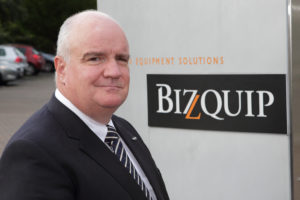It’s all about pace
The pace of change will provide risks and opportunities, but it will be the guiding force
By Paul Hearns, editor, TechPro

Planning is one of the things we tend to do at this time of year, and a standard part of many a business plan is the SWOT analysis, or strengths, weaknesses, opportunities and threats.
Well, adapting this ever so slightly, I thought I would look at three key themes for this fledgling year, under the headings of those things that are likely to be of greatest impact or influence on information and communications technology (ICT) for business, the greatest risks and the greatest opportunities.
These thoughts are distilled from the absorption of all the coverage of enterprise ICT in which we have been immersed for the past 12 months, and are, in the manner of all advice, tips, predictions or consultancy, to be taken with a grain of salt, or not at all.
Firstly, for Irish organisations, I think one of the single greatest influences for 2018 is going to be the General Data Protection Regulation (GDPR). Both the race for compliance, and the immediate aftermath of the deadline of 25 May, will see major changes for organisations in how they gather, store and process data where it is made up, in whole or in part, of personally identifiable information.
I refer to it as a race whereas previously I called it a journey, because as there will be, by the time you read this in the early weeks of January, less than 5 months left in which to get compliant. If you have not already started, then it is a race. Get going!
I saw, with some amusement, a December event that offered practical advice to get organisations started. I certainly hope that one of the first pieces of advice given was ‘what are you doing going to events when you should be working on your GDPR plan?’
“I saw, with some amusement, a December event that offered practical advice to get organisations started. I certainly hope that one of the first pieces of advice given was ‘what are you doing going to events when you should be working on your GDPR plan?’”
This is prompted by the advice from a compliance officer for a large organisation that is responsible for millions of transactions per week for customers, who said that until your data discovery was done, it was impossible to know how big the job is.
That was last September.
Looking to the weeks and months after the deadline, the broad expectation is that our data protection commissioner will start to request documentation on compliance from organisations. Rather than go hell for leather into investigations, the office will look to see how organisations have documented their compliance. This is a key difference with other types of compliance efforts, as organisations must be able to demonstrate that they are compliant, and a key element of this will be their documentation.
I would advise having a stamped envelope ready for 25 May.
In terms of other things that will impact, I think the sheer pace of change is a key—often underestimated—influence too. The rate at which technology can be acquired and deployed, enabling organisations to either pivot current practices, processes or operations, or even stand up entirely new lines of business is, quite frankly, staggering. That means that from opportunity to exploitation can be reduced by many orders of magnitude. This is no seasonal rush, or flag day response, this is the ability of an organisation to react to, or indeed be in lock-step with a market trend, a new demand or simply being first to market with a desirable offering.
When this is combined with the DevOps approach of a ‘good enough’ delivery, especially as a first offering, it means that speed is of the essence, and so older styles of development, quality control, project planning and milestone delivery are now as archaic as night sticks, spats and smoking beneath a lamp post.
However, this leads into what has to be one of the key risks for 2018. We all hear all the time about the security landscape and black hats and nations states, et cetera. I’m not going there this year. Instead, the above point highlights a far more real risk for Irish organisations of all sizes. The ability of a competitor, or new market entrant to jump into a new area and immediately begin offering something is now greater and faster than ever before.
To simply keep pace, means constantly moving. The risk therefore, is to stand still, do nothing. The pace of change and innovation is currently so fierce that doing what you are currently doing without an eye to the future and new developments is actually going backwards. By the time many organisations figure out that they have been overtaken, they are so far behind where they need to be, that it may seem impossible to get current, let alone nose ahead.
It is critical to remember that the opportunities for transformation to a digitally-enabled organisation are there for everyone, partner, customer, competitor, upstart. So, seize the opportunity. As the old bear joke goes, you don’t necessarily have to be the fastest, just faster than the slowest.
However, other risks exist for Irish organisations too.
Brexit is not going well, and many Irish organisations will find themselves in awkward situations in terms of suppliers, partners, parent organisations and branch offices. The unfortunate reality is that it may yet be quite some time before a realistic picture of the future trade relationship between the EU and the UK emerges, at which point Ireland will have to work with the UK to fill in the gaps of just how this island will work. I wish I could offer greater insight, but I fear there is little to be had as yet. What I do have confidence in is the pragmatism of people both sides of the border, who having enjoyed prosperity in the last decade or so, are unwilling to lose the conditions that facilitated it. That is worth more than any political manoeuvring either in London or Brussels.
In terms of opportunities, I again return to the pace of change, and add in that other great axiom of ‘fail fast’. The speed with which change can now be achieved also means that when something is not working, it can be killed immediately, often without huge loss due to the new consumption-based models on which so much is based.
That allows organisations greater freedom to try, to experiment. Failure is the greatest teacher, and all efforts can contribute to understanding and insights that may go on to form the germ of something more successful. However, the key point tis to try—innovate, experiment and use the confluence of accessibility, flexibility and availability in technology to release the creativity in your organisation.
No one knows more about your organisation than your own people. Allow them to bring that knowledge and their insights for what customers want to bear on the issues being faced. It is more achievable than ever before with the tools and technologies available, but also there is a new level of acceptance that every person in an organisation can contribute to its success. I am always reminded of the razor that the CIO of a Formula 1 team used to apply to new technologies: will it make the car go faster? But the way that this philosophy was applied meant that even the people making sandwiches in the canteen got a bonus when the team scored championship points, recognising their part in the whole.
So, as we face into a new year, one of the only things that is certain is change, and rapid at that, don’t be the organisation drowning beneath the wave, be the one surfing it.
Consumer hand
Developments in consumer tech will undoubtedly be felt in enterprise sooner or later
By Alex Meehan

Any discussion of what’s likely to dominate in the IT community in 2018 has to begin with mention of the General Data Protection Regulation (GDPR).
Due to come into full effect on May 25, 2018, the reverberations of GDPR will be felt for years to come, bringing with it as it does the potential to significantly change the way companies based in the EU are obliged to deal with personal data.
GDPR extends the scope of EU data protection law to all foreign companies processing the data of EU residents, harmonizing data protection regulations throughout the EU and it comes with a significant barb in its tail. Companies found not to respect the regulation can be hit with penalties of up to four per cent of their worldwide annual turnover.
Most observers agree that GDPR is largely a good thing—as consumers, we all create, distribute and consume ever increasing amounts of personal data, and it stands to reason there should be protections in place to control how that data is stored, protected and commercially exploited.
In a related issue, the consequences of the 2016 Brexit vote continue to be enormous and will undoubtedly play out in 2018, creating headaches in the area of immigration and the economy, and causing uncertainty for companies dealing with both the UK and Europe.
Soon companies with connections to the UK will have to decide what to do to prepare themselves for full Brexit. Many observers are looking to GDPR to offer some promise of stability in the market in the run up to Brexit – it will apply in the UK for a period of around a year before the country formally exits the EU. Could that offer some reassurance for companies engaged in planning at the moment?
“Cloud and hybrid cloud are just how business is done in the tech sector, and in 2018, it looks certain that companies hoping to add to their IT estate will investigate cloud-based options first”
“The way we look at it is this—the UK is still going to have to comply with GDPR from May 2018 through to March 2019 when it has committed to leaving the EU. So there’s going to be a 12-month period there where it will be in effect,” said Richard Howard, head of technology, media and telecommunications for Deloitte.
Elsewhere in the tech sector, 2017 was the year that the cloud went truly mainstream. All the arguments rolled out by early adopters were accepted into the narrative – cloud really is a more convenient and affordable way to access software, resources, compute power and infrastructure, even if it isn’t always as cheap as we were once led to believe it would be.
Cloud and hybrid cloud are just how business is done in the tech sector, and in 2018, it looks certain that companies hoping to add to their IT estate will investigate cloud-based options first.
According to a report published by 451 Research, 41 per cent of all enterprise workloads are currently running in some type of public or private cloud. By mid-2018 it’s expected that this will rise to 60 per cent, and as a result a majority of enterprise workloads will run in the cloud in the near term. These are significant figures, with significant implications.
“The cloud provision market is particularly buoyant right now as it expands right around the world. Cloud providers are rapidly deploying the correct infrastructure to meet the needs of enterprises as they move their workloads into the cloud,” said Gary Keogh, sales director with Digital Realty. “More and more companies are moving into the cloud – that’s what our experience as well as the statistics and market research says.”
Next year also seems likely to be a year that will deliver savings to cloud customers as increased competition drives prices down. To take one example, Amazon Web Services says it has reduced its prices on basic cloud services 59 times since it launched in 2006 and it aims to continue doing so in 2018.
“Those cost reductions have been proactive so when we reduce costs, customers immediately benefit. If you’re a long term AWS user your bill will naturally go down and there’s no need to come to us to ask for a price reduction,” said Ian Massingham, chief evangelist for the EMEA region for Amazon Web Services. “When we announce a cost reduction, customers immediately benefit from that effective date and on a few occasions we have actually backdated those reductions.”
The Internet of Things is surely going to continue its path towards the mainstream in 2018, becoming more visible as more applications find their way into the market. While most consumers think of wearables and home security systems in association with IOT, the public and enterprise world of connected devices such as street lighting and energy meters are seeing large amounts of growth.
However, it is often with the consumer that new technologies achieve mass adoption, and already cloud-connected home assistant devices such as Google’s Home, Amazon’s Echo and Sonos’ One devices have sold well.
In the first quarter of this year, Apple is expected to launch it’s much delayed HomePod device. Whenever Apple turns its enormous marketing machine to a device category, it has the knack of floating all boats in that category pretty quickly.
It was the first to market with an artificial intelligence system in the form of Siri, but has since lagged behind competitors. However, home automation systems offer an opportunity for it to redeem itself – recent research from US-based Technalysis Research showed that 50 percent of people who have home assistant speakers use their AI systems at least once a day, compared to only 30 per cent of smartphone owners.
Meanwhile Apple, along with Facebook and Google, are also likely to bring social payments to the masses through a variety of devices in 2018. All of this will serve to create opportunities for developers to apply their creativity and come up with use cases that will undoubtedly touch the enterprise market.
All about the data
Information technology’s natural state is one of flux but while 2018 is unlikely to see radical changes in consumer IT, we will see the maturation of several important trends in enterprise-level technology
By Jason Walsh

2017 has certainly been an interesting year for technology, though the truth is you would struggle to find a year that wasn’t. What is notable, however, is that consumer demands no longer appear to be at the leading edge of developments. And why not? No new processor or operating system changes much for the consumer now that the processing power in your pocket is beyond what we ever needed on the desktop, and streaming and social media have settled into prosaic roles as the primary uses of the internet.
This will doubtlessly change when new areas become mainstream—perhaps it will be virtual reality, but, then again, history suggests perhaps not. For now, though, other areas of IT seem set to take the lead—and many of the developments are at the backend.
Over the last five years cloud computing has become the norm, thanks not only to the explosion in connectivity and processing power, but also the calming of initial security fears. The cloud has created, first and foremost, a new take on Adam Smith, creating no less than an entirely new division of labour. Generalist in-house IT departments increasingly are increasingly pushing workloads out to the cloud, whether to the heavily promoted public clouds of Amazon and Microsoft, or to private cloud deployments looked after by specialist service providers. The net result has been an expansion not only of IT use, but also IT employment, and this seems likely to continue throughout 2018, but the threat of de-professionalisation lurks: why bother having a full-scale IT department when you can buy in a white label service?
“Both AI and ML are already part of enterprise activity and that trend can only accelerate with more and more tasks, for example security, taking advantage of increased computational power. Right now much of the focus is on marketing, but AI’s potential is greater than just a new means of showing people things that they might like to buy”
Alongside the cloud, of course, comes big data. Hitherto the preserve of massive multinationals, data is well on its way to becoming the lifeblood of business, in the process creating new jobs and job categories such as data scientist, as well as entire academic sub-disciplines to study and research the underlying processes.
With data there is also machine learning (ML) and artificial intelligence (AI). One of the most hyped technologies since the invention of computing, AI has ebbed and flowed with the decades. In truth there is still something of the hype machine about AI. So-called ‘general artificial intelligence’—the dream, or nightmare, familiar from science fiction—is no closer than ever, but that doesn’t mean that AI isn’t having an impact on business processes in the here and now. Indeed, both AI and ML are already part of enterprise activity and that trend can only accelerate with more and more tasks, for example security, taking advantage of increased computational power. Right now much of the focus is on marketing, but AI’s potential is greater than just a new means of showing people things that they might like to buy.
As it expands into non-IT domains we are likely to hear more about its potential deleterious effects, in particular whether or not the ‘next industrial revolution’ will be a jobless one. McKinsey consultants estimated that that 22 per cent of a lawyer’s job can already be performed by a machine. While IT boosters—who often make a living from the technology they are advocating for, or at least from prognosticating about it—are quick to tell us that technology creates more jobs than it destroys, there is no law that says this is necessarily the case. Moreover, even with past cases of industrial displacement, such as steelworkers and miners, there is no guarantee that those who are displaced will find gainful employment.
This will necessarily have political consequences. Consider this: there are currently more professional truck drivers in the US than there are computer programmers. We are already seeing AI married with robotics to produce autonomous vehicles, and Tesla wunderkind Elon Musk has unveiled very real plans for autonomous lorries. Leaving aside any questions about the safety of self-driving vehicles and moral questions about who will be responsible for the ‘trolley problem’ of what they should to in the face of an inevitable collision, this technology will have profound moral—and political—consequences. As autonomy and robotics progress, political instability is not unimaginable, such that we could come to look upon the last decade as high water mark for amity and reason.
And still, given the benefits to commerce and government efficiency the march of machines seems inevitable, with those few opposed to it seeming like modern day Canutes. AI and ML themselves are not expensive; what is expensive is data. Anyone who has data, then, is already being invited to the AI party, and his has not gone unnoticed. Popular business tools already in use are providing more and more tools to not only sort data, but to mine it for value.
The value of data creates its own problems and this certainly been recognised in government and activist circles. As a result, data will also have to be considered from another point of view: privacy. The EU’s General Data Protection Regulation (GDPR) is already law right across Europe, but will be enforced from May 25, 2018, at which point anyone holding personally identifying information will be subject to eye-watering fines not only for breaches, but for potential breaches. Apart from creating a boom for consultants, the GDPR will mean that data compliance and security will become a central activity of enterprise IT.
Another area we are likely to see major developments is blockchain. At the time of writing BitCoin is on the cusp of transforming from being a bonanza to a bubble, at least in terms of media perception, but even if the bust does come the underlying technology of blockchain may turn out to be more transformative than BitCoin itself. Effectively a distributed database, blockchain does not sound radical—and yet it is.
Its effect on the wider economy could be transformative, but, that aside, simply as a technology it is fascinating. The more prosaic concerns about blockchain—not least energy use—cannot be waved away, but the technology has the potential to do more than drive speculative investment opportunities, creating a raft of new professionals and the technology for them to administer.
Predicting the future is a mug’s game, and all that can be said with certainty is that 2018 will be a year of change. The trend underlying it all, though, is clear: increasingly, everything is about data.
| Data-driven business | |
| “As a matter of urgency, every business needs to become data driven if it wants to thrive in these uncertain economic times” |  Ergo John Purdy, CEO |
| Ergo has been using digital channels to collect and mine data for so many years now that we’ve become a data-driven business. As we go into 2018, I’d argue that as a matter of urgency, every business needs to become data driven if it wants to thrive in these uncertain economic times, and it will come as no surprise to hear that the technology we use is precisely what we share with our clients. We make sure data analytics is a key pillar in their digital transformation strategies as good data enables better and more informed decisions.We know first-hand how a new wave of tools are available to help understand customer sweet spots, enabling us to profile them in granular detail to identify their business needs and challenges. With Power BI, Microsoft’s interactive visualisation tool, employees from different parts of a company can get the insights they need to make more informed decisions. Understanding customer preferences and what drives behaviour will give you visibility of where your profits are coming from and allow you to build more solid and sustainable customer relationships.
Five years ago CRM was a fancy and expensive Rolodex. Now it is a seamless digital process that will remove silos in your business and enable you to optimise every sales opportunity. And it is just one part of your digital sales and marketing armoury. Modern sales directors have so many more channels at their disposal, making it possible to forge relationships with potential prospects in ways that simply didn ot exist a decade ago. Part of becoming a digital business is about having a strong digital presence – this means leveraging social media to engage in conversations and share your ideas over the web. Any business looking for a supplier will undertake extensive due diligence into potential vendors before making a decision. LinkedIn, YouTube and blogs are all channels you should leverage to convey who you are and why you’re different. If you don’t use them, you risk dropping out of the race at the first hurdle. Underpinning all of this activity is the cloud and mobility, enabling all the services I have described to be available anytime, anywhere, on any device. This has changed some fundamentals about running a business. Again, Ergo has experienced this first hand. As employees work different hours in different ways, it is collaboration and communications solutions that keep us together and helps define us as a company, not office walls or desk space. In 2018, I look forward to talking to businesses that may be struggling with some of these ideas and reassuring them that a robust business case can be made for all of them. We have a progressive and solid foundation in technology but we know it is not what gets CEOs excited. They want to talk about revenue growth, margin improvements, customer retention – not technology. Ultimately, our only purpose is to deliver outcomes that will make our customers more competitive. Our expertise is in making technology a means to that end.
|
|
| Seamless and secure process | |
| “Look around your office and you will see the impact of technology on the way that we work everywhere. Digitisation of technology, video calls and interactive whiteboards are all part of a workplace revolution” |  Bizquip Jim Leyden, managing director |
| Technology has transformed the world in the last 20 years. It has created more disruption and innovation than we have ever seen. This has given rise to a new breed of organisation, born with technology, with virtual products and speed and agility unprecedented when compared with traditional business processes. Look around your office and you will see the impact of technology on the way that we work everywhere. Digitisation of technology, video calls and interactive whiteboards are all part of a workplace revolution.In the last year in particular, Bizquip has seen an emerging trend from our clients towards digital transformation. We are seeing an increase in the amount of companies requesting to implement cost controls and put management tools in place around document workflows operating across businesses and adopt new ways of working to increase productivity. As companies endeavour to keep pace with the latest technology to support excellence in the client and employee experience. Applying Bizquip’s Solutions Approach: Discovery – Analysis – Solution design – Continuous Management. Our equipment and document technology solutions team has been leading businesses through this change in a seamless and secure process.
Bizquip helps companies to create innovative and progressive workspaces and develop new future proof business models. Recently, Bizquip assisted RSM Ireland, the sixth largest global audit, tax and consulting network redefine and design a streamlined print management solution to drive cost and efficiency benefits. If we look at Gartner’s 2017 Hype Cycle, the consultancy’s annual examination of emerging technologies, several key trends emerge. Virtual reality, machine learning, deep learning and augmented data discovery are all highlighted for mainstream adoption within the next two to five years. These technologies are set to directly impact workplace productivity, helping employees work smarter and faster. The changing world of work, the digitisation of the office has fundamentally changed the landscape and this has driven the need to change across many businesses and marketplace. The recent Ricoh Ireland survey shows that 51% of Irish businesses are not fully embracing digital transformation, while 85% of companies are finding it more difficult to manage and secure business documents.
|
|
| The power of the image | |
| “Through strategic acquisitions of network security companies, Canon has evolved its capabilities in the network camera sector” |  Canon Ireland Philip Brady, country manager |
| At Canon Ireland, a focus for us in the next year and beyond is “The Future of The Image”. Key new business areas for Canon in 2018 are office solutions software, B2C software acquisitions, and heavy investment in network camera solutions.Canon has developed and honed its P2P offering to become an industry leader. Canon’s offerings in this area enable procurement and finance to work better together; on a single integrated platform, you can realise improved spend control and cash-flow management — all mobile enabled. In Ireland, Canon recently won several state contracts to provide P2P services, and hopes to expand this into 2018.
For B2C, Canon hopes to develop two major recent acquisitions: irista, their first cloud-based management platform for consumers passionate about photography; and Lifecake, a family based photo-sharing app which allows parents to store, organise, share, and relive key moments of their children’s lives. Through strategic acquisitions of network security companies Milestone and Axis, Canon has evolved its capabilities in the network camera solutions market sector. Currently, Canon has the largest security camera network in Europe, and wants to grow and expand this in 2018 — combining high-quality image processing technology with a strong heritage in lens design and an expertise in networking. With digital transformation, the pace of change is ever increasing. Canon’s ongoing passion for the power of the image has extended into new markets, and will continue to grow in 2018 — ensuring that the demands of customers are met today and into the future.
|
|
| Real delivery | |
| “Our expectation is that we will see the real delivery of full managed services, managing the infrastructure and availability at one end to the endpoint security, data leakage, patching on another end” |  Renaissance Michael Conway, director |
| The 2018 vision is something that people have predicted for a long time but which has not been fully delivered through the channel yet. The delivery of true managed services solutions based on an OpEx payment structure will enable users to leverage their investments in technology and grow as they need without a major investment. This will be more effective within the security and compliance area of technology than in other sectors. Our expectation is that we will see the real delivery of full managed services, managing the infrastructure and availability at one end to the endpoint security (including anti-virus and ransomware protection), data leakage, patching on another end. The perimeter protections around web, email and firewall are all readily available on a true managed services basis with full OpEx models available for all. The delivery of true managed services solutions and managed security service solutions will, Renaissance believes, be the change that delivers the next great step in the marketplace. The ability of any organisation to leverage their investment will underlie this market change. Ultimately the agility and capabilities which these changes will offer will mean that those who rely on legacy solutions will be in a difficult place – this goes for the users and channel partners who choose to remain with the older structure and don’t embrace the winds of change. Competitive advantage for all relies on agility, ability to identify challenges and respond to them in a timely and cost-effective manner. True managed services will enable this! |
|
| Solutions for growth | |
| “The ability to respond quickly and accurately to shifts in customer behaviour will be vital in tomorrow’s world as businesses and people become more demanding, as well as tech savvy” |  Singlepoint Rob Curley, managing director |
| We are already seeing massive growth among businesses that are aggressively executing a clear digital transformation strategy and looking to capture ideas and get prototypes delivered much faster than before. Digital change will be harnessed through a combination of digital technology, digital culture and partnering with specialists to accelerate digital transformation.There is an increased interest in machine learning and cloud solutions. The ability to respond quickly and accurately to shifts in customer behaviour will be vital in tomorrow’s world as businesses and people become more demanding, as well as tech savvy. Machine learning will assist in these efforts. Machine learning is as much about the organisation’s buy-in, and availability of quality data that will make it successful. At Singlepoint, we are building our own solutions in areas that we see high growth, so we can come in and just switch it on for clients.
Chatbots are another area that is of particular interest to us. We have built a number of them and we see there is a big opportunity for them in terms of cost optimisation. Already, we are seeing that a lot of people are happy to use bots if they get the answer they need, they are intuitive, equipped with the ability to improve their efforts from continual learning algorithms and serve to meet the demands of the fast-paced, hyper-connected digital world in which we live.
|
|








Subscribers 0
Fans 0
Followers 0
Followers